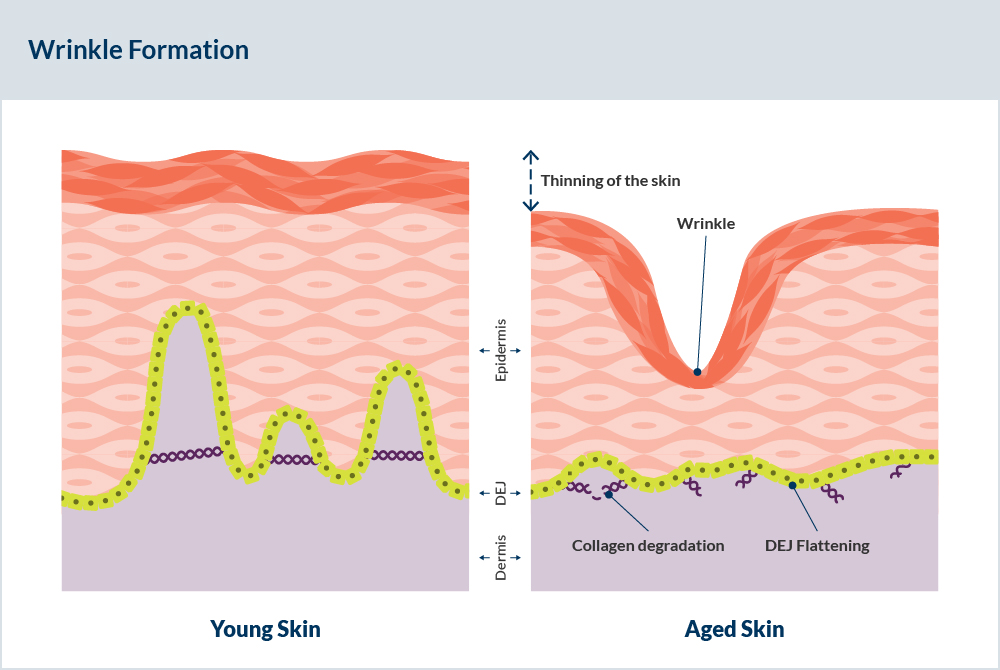Wrinkles

Wrinkles: Definition and Characteristics
What are Wrinkles?
Wrinkles are visible lines, folds, or creases that develop in the skin, commonly as a result of aging and environmental factors. They represent a natural part of the skin’s aging process caused by loss of collagen and elastin, the proteins responsible for skin’s firmness and elasticity. Wrinkles typically appear on the face, neck, and hands, where skin is thinner and more exposed to environmental damage.
Characteristics
Mechanism
Wrinkles form through a combination of intrinsic and extrinsic factors:
- Intrinsic aging: Gradual reduction in collagen and elastin synthesis, decreased skin cell turnover, and reduced natural skin oils result in skin thinning and reduced elasticity.
- Extrinsic aging: Environmental factors such as ultraviolet (UV) radiation from sun exposure, smoking, pollution, repetitive facial expressions, and poor nutrition accelerate collagen breakdown and promote free radical damage, deepening wrinkles.
- Dynamic wrinkles appear with muscle movements like smiling or frowning, while static wrinkles remain visible even at rest due to structural skin changes.
Symptoms
Commonly manifests as fine lines, deeper furrows, crow’s feet around eyes, forehead lines, nasolabial folds (smile lines), and marionette lines around the mouth. Wrinkles can vary in depth and severity and may cause cosmetic concerns but do not cause physical symptoms.
Risk Factors
Genetics play a significant role in wrinkle formation. Additional risk factors include chronic sun exposure, tobacco use, repetitive facial movements, environmental pollutants, aging, and inadequate skincare or hydration.
Clinical Significance
Wrinkles affect aesthetic appearance and can impact psychological well-being. Numerous cosmetic treatments are available, ranging from topical retinoids and antioxidants to minimally invasive therapies like botulinum toxin injections, dermal fillers, chemical peels, microneedling, and laser resurfacing to reduce their appearance. Preventative measures, including sun protection and healthy lifestyle habits, are essential for managing wrinkle development.
Key Points
- Wrinkles are creases or folds in the skin due to aging and environmental damage.
- Loss of collagen and elastin along with repetitive muscle activity contribute to wrinkle formation.
- Multiple types include dynamic, static, and deep furrows.
- Treatment options include skincare, injectables, resurfacing, and surgical procedures.
- Sun protection and lifestyle modifications are critical for prevention.
Consult with Our Team of Experts Now!
For personalized wrinkle assessment and tailored treatment plans using Cellular Therapy and Stem Cells, consult with our dermatology and cosmetic specialists for expert care and natural-looking rejuvenation.
References:
- Zague V. Collagen Supplements for Aging and Wrinkles: A Paradigm Shift in Dermatology. Skin Pharmacol Physiol. 2021 Dec 31;34(1):1-15. doi:10.1159/000516299. Available at: https://pmc.ncbi.nlm.nih.gov/articles/PMC8824545/
- Chavoshnejad P, et al. Effect of Collagen Degradation on the Mechanical Behavior and Wrinkling of Skin. Phys Rev E. 2021 Sep 9;104(3):034406. doi:10.1103/PhysRevE.104.034406. Available at: https://doi.org/10.1103/PhysRevE.104.034406
- Holland D, et al. Collagen Peptides Affect Collagen Synthesis and the Expression of Related Genes in Human Dermal Fibroblasts. Front Med (Lausanne). 2024 Apr 30;11:1397517. doi:10.3389/fmed.2024.1397517. Available at: https://doi.org/10.3389/fmed.2024.1397517
- Quan T, et al. Molecular Mechanisms of Dermal Aging and Antiaging Approaches. Int J Mol Sci. 2019 Apr 28;20(9):2126. doi:10.3390/ijms20092126. Available at: https://pmc.ncbi.nlm.nih.gov/articles/PMC6540032/
- Zhang S, Duan E. Fighting against Skin Aging: The Way from Bench to Bedside. Cell Transplant. 2018 May;27(5):729-738. doi:10.1177/0963689717725755. Available at: https://journals.sagepub.com/doi/10.1177/0963689717725755















